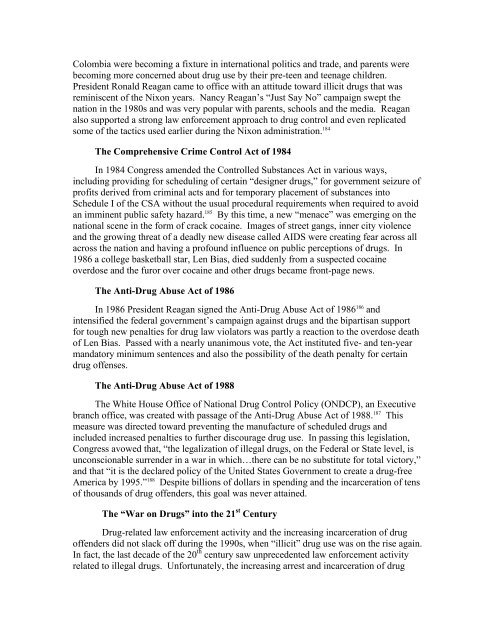Effective Drug Control: Toward A New Legal Framework
Effective Drug Control: Toward A New Legal Framework
Effective Drug Control: Toward A New Legal Framework
You also want an ePaper? Increase the reach of your titles
YUMPU automatically turns print PDFs into web optimized ePapers that Google loves.
Colombia were becoming a fixture in international politics and trade, and parents were<br />
becoming more concerned about drug use by their pre-teen and teenage children.<br />
President Ronald Reagan came to office with an attitude toward illicit drugs that was<br />
reminiscent of the Nixon years. Nancy Reagan’s “Just Say No” campaign swept the<br />
nation in the 1980s and was very popular with parents, schools and the media. Reagan<br />
also supported a strong law enforcement approach to drug control and even replicated<br />
some of the tactics used earlier during the Nixon administration. 184<br />
The Comprehensive Crime <strong>Control</strong> Act of 1984<br />
In 1984 Congress amended the <strong>Control</strong>led Substances Act in various ways,<br />
including providing for scheduling of certain “designer drugs,” for government seizure of<br />
profits derived from criminal acts and for temporary placement of substances into<br />
Schedule I of the CSA without the usual procedural requirements when required to avoid<br />
an imminent public safety hazard. 185 By this time, a new “menace” was emerging on the<br />
national scene in the form of crack cocaine. Images of street gangs, inner city violence<br />
and the growing threat of a deadly new disease called AIDS were creating fear across all<br />
across the nation and having a profound influence on public perceptions of drugs. In<br />
1986 a college basketball star, Len Bias, died suddenly from a suspected cocaine<br />
overdose and the furor over cocaine and other drugs became front-page news.<br />
The Anti-<strong>Drug</strong> Abuse Act of 1986<br />
In 1986 President Reagan signed the Anti-<strong>Drug</strong> Abuse Act of 1986 186 and<br />
intensified the federal government’s campaign against drugs and the bipartisan support<br />
for tough new penalties for drug law violators was partly a reaction to the overdose death<br />
of Len Bias. Passed with a nearly unanimous vote, the Act instituted five- and ten-year<br />
mandatory minimum sentences and also the possibility of the death penalty for certain<br />
drug offenses.<br />
The Anti-<strong>Drug</strong> Abuse Act of 1988<br />
The White House Office of National <strong>Drug</strong> <strong>Control</strong> Policy (ONDCP), an Executive<br />
branch office, was created with passage of the Anti-<strong>Drug</strong> Abuse Act of 1988. 187 This<br />
measure was directed toward preventing the manufacture of scheduled drugs and<br />
included increased penalties to further discourage drug use. In passing this legislation,<br />
Congress avowed that, “the legalization of illegal drugs, on the Federal or State level, is<br />
unconscionable surrender in a war in which…there can be no substitute for total victory,”<br />
and that “it is the declared policy of the United States Government to create a drug-free<br />
America by 1995.” 188 Despite billions of dollars in spending and the incarceration of tens<br />
of thousands of drug offenders, this goal was never attained.<br />
The “War on <strong>Drug</strong>s” into the 21 st Century<br />
<strong>Drug</strong>-related law enforcement activity and the increasing incarceration of drug<br />
offenders did not slack off during the 1990s, when “illicit” drug use was on the rise again.<br />
In fact, the last decade of the 20 th century saw unprecedented law enforcement activity<br />
related to illegal drugs. Unfortunately, the increasing arrest and incarceration of drug
















